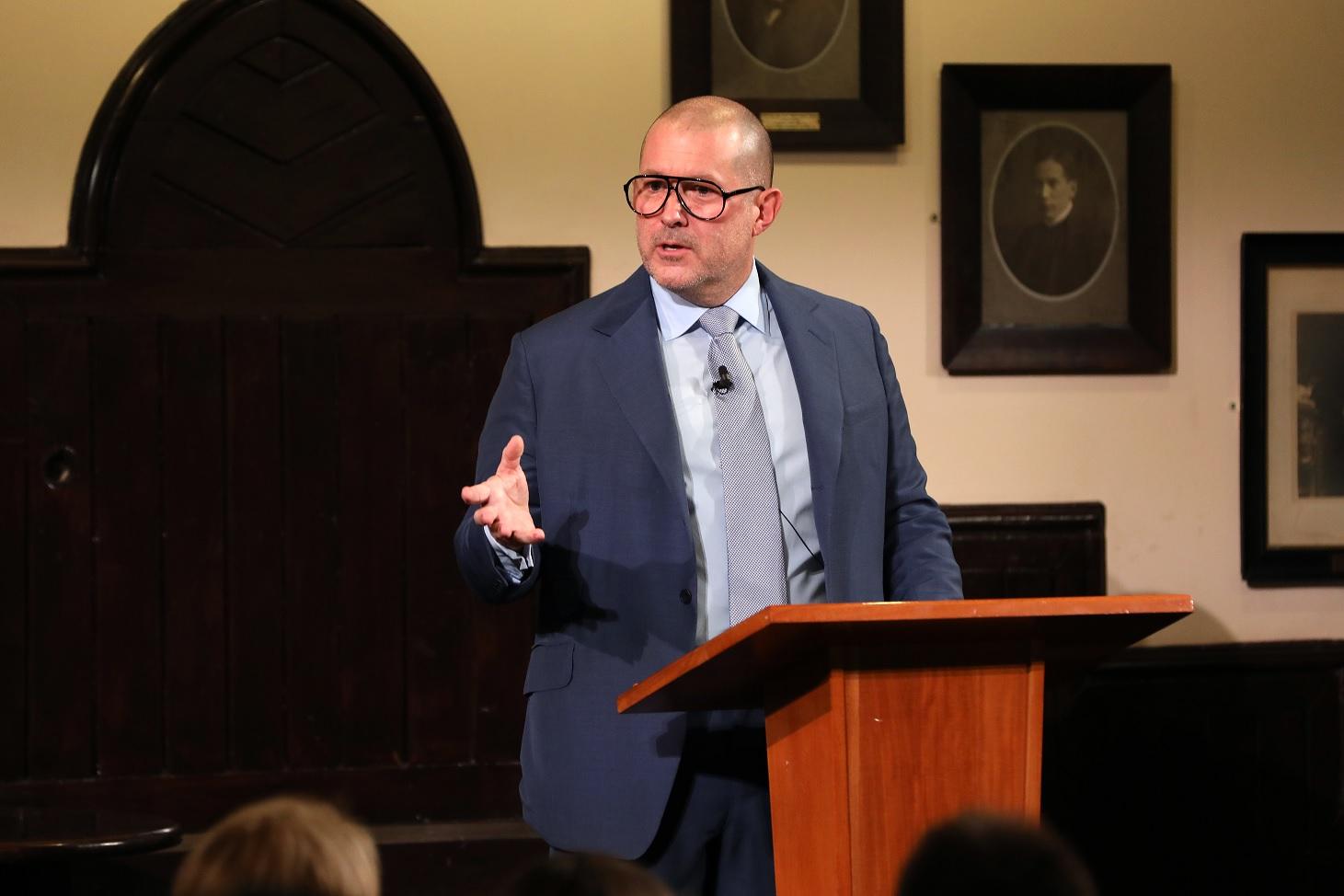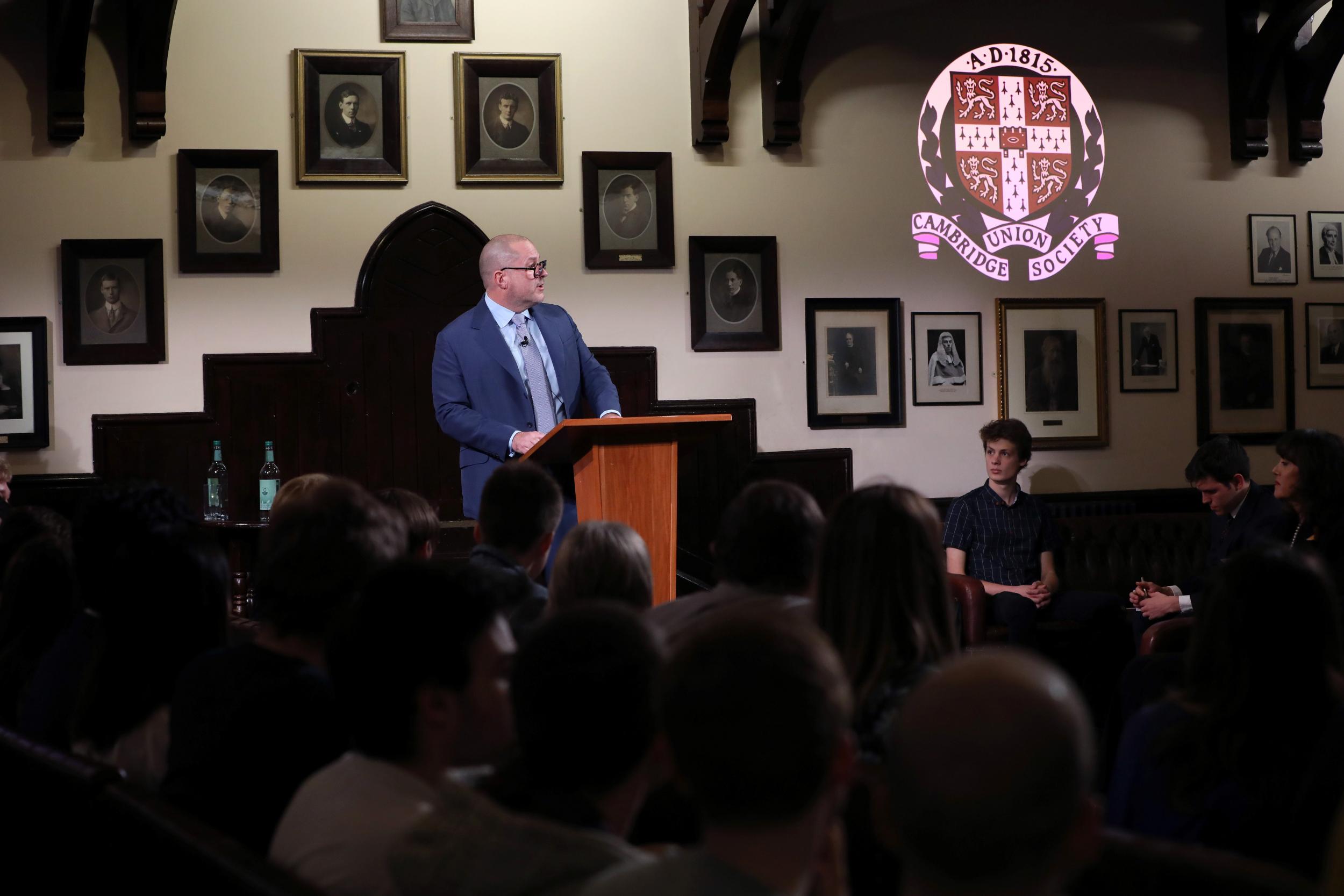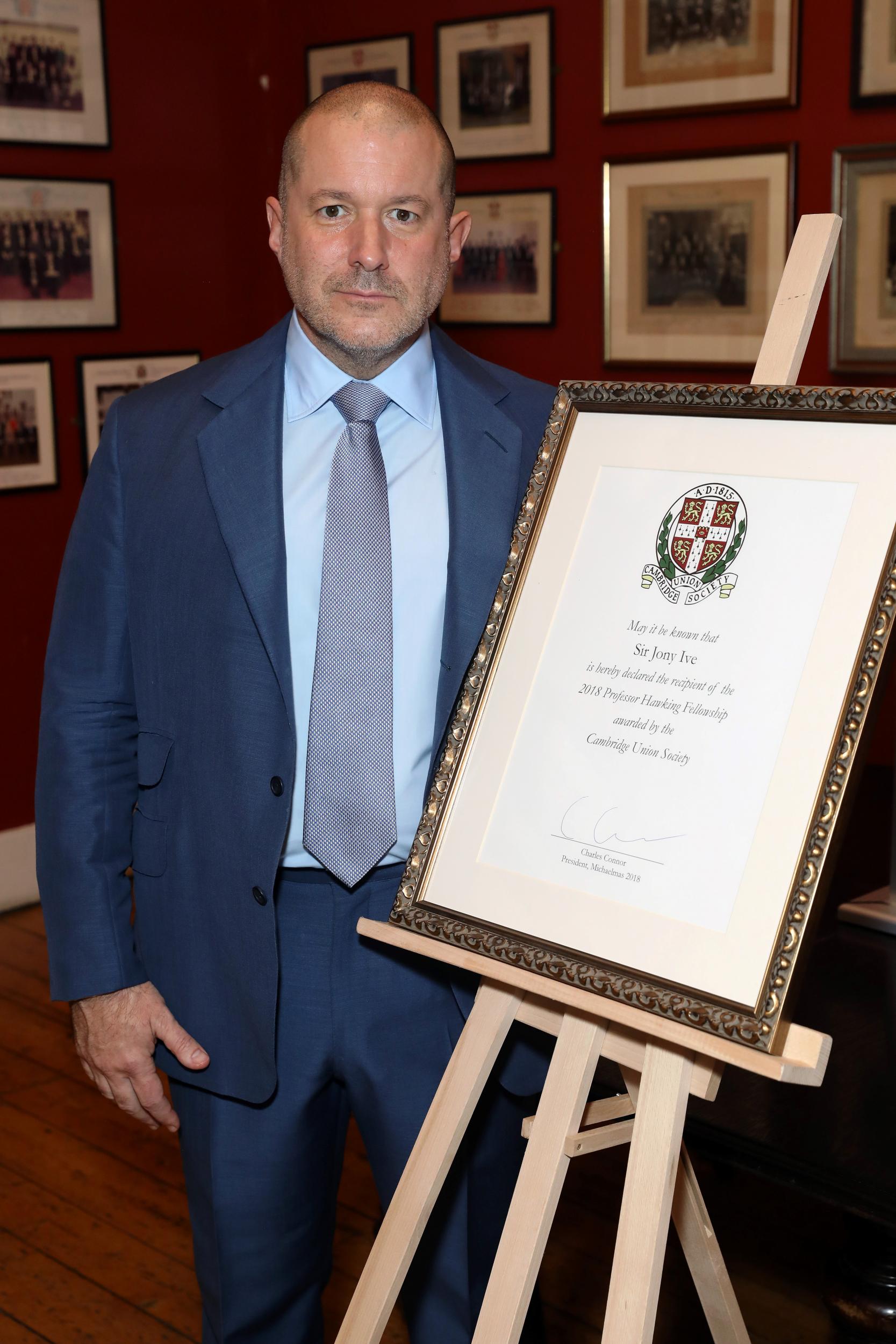Apple designer Jony Ive explains how ‘teetering towards the absurd’ helped him make the iPhone
'I find it happens to me once or twice a day and that frequency of shifting between two such different ways of seeing and thinking is fantastically demanding'

Your support helps us to tell the story
This election is still a dead heat, according to most polls. In a fight with such wafer-thin margins, we need reporters on the ground talking to the people Trump and Harris are courting. Your support allows us to keep sending journalists to the story.
The Independent is trusted by 27 million Americans from across the entire political spectrum every month. Unlike many other quality news outlets, we choose not to lock you out of our reporting and analysis with paywalls. But quality journalism must still be paid for.
Help us keep bring these critical stories to light. Your support makes all the difference.
The Cambridge Union is used for impassioned debates. The hall is divided in two, with rows of seats facing each other, adversarially. But the first recipient of the Stephen Hawking Fellowship, apart from the professor himself who gave the initial Fellowship speech last year, was anything but combative.
Sir Jonathan Ive, Chief Design Officer at Apple, was awarded the fellowship because he fulfilled its twin criteria, as explained by Charles Connor, President of the Cambridge Union for the Michalemas term. Connor said Ive showed flair in the STEM (Science, Technology, Engineering and Mathematics) fields and the ability to communicate complex ideas in a way to excite the imagination.
Jony Ive, as everyone calls him, made a speech that was intellectually rich but still accessible, dense with ideas and fascinating. He spoke eloquently, gently, even tenderly, about the creative process and the importance of listening to the quietest voice. Throughout, he was open and humble, repeatedly revealing the curiosity which is a central part of doing his work.

The Union’s main hall holds around 400. It was packed, mostly with students. Ive stood in the dead centre of the hall, turning back and forth between the facing rows, elegantly but quietly dressed in an immaculate blue suit, pale blue shirt and tie.
"We designers create tools, tools that you can live in, sit on, eat with, tools that enable communication and support learning, creating and mending. Our tools can be powerful, they can be beautiful, and on many occasions they're not motivated by understood or articulated needs."
But though Ive works in the world of technology, he recognises it can be challenging.
"As an aside, it's interesting, isn't it, when we struggle with technology, we assume the issue is actually with us. If you eat something that tastes dreadful, you don't assume that the issue is with you. I just thought I'd mention that."
Although he had worried that he was technologically inept, his first encounters with an Apple Mac changed everything.
"With the Mac, in 1988, I think I learned two things. Firstly, I could actually use it. I loved using it and it became a very powerful tool that helped me design and create. Secondly, and I think this is in some ways a rather embarrassing admission because this was at the end of four years of studying design, I realised that what you make represents who you are.
"It stands testament to your values and your preoccupations, and using the Mac I sensed a clear and direct connection with the people who actually created the Macintosh. For the first time, I remember being moved by obvious humanity and care beyond just the functional imperative. "
This, he said, led to him finding out more about the people at Apple and moving to California in 1992 to join the team.

But his most interesting thoughts concerned creativity and the nature of ideas. "I spend my time at Apple in that intersection of art and technology. I think that, almost by definition, ideas are fragile. If they were resolved, if they were robust, they wouldn't be ideas any more, they would be shipping products, a finished album, a completed building. I'm not really entirely sure why, but I think I've always taken an enormous delight when the most tentative thought, often from the quietest voice, evolves into significant and substantial products."
As he described the process that surrounded one interface project which began in around 2002 to 2003, he intriguingly revealed that the concept of the Apple App Store began a long time ago.
"This was a project that we came to describe as multi-touch. Some of you may remember the first time you experienced the interface. Perhaps it was on one of the first iPhones or later on an iPad. But multi-touch describes the ability to directly touch and interact with your content to be able to pinch to zoom an image or flick through a list with your fingers.
"Importantly, it defined an opportunity to create applications with their own unique, very specific interface. So, not being generic but being specific inherently describes the application's function. We came to see that we could make applications purposeful, compelling and intuitive to use. And so, as the potential for a vast range of apps became clear, so did the idea for an app store."
But it took time before it could happen: "In reality, the supporting technology, the enabling technology, took years to catch up with the ideas. And I have to say the ideas posed problems and defined challenges, but in the process, we came close to giving up on a number of occasions."
Thankfully, they didn't give up. But ideas, he said, were not in response to a defined problems. "Nobody asked us to solve a problem. They were not in response to a technological opportunity. These ideas, they weren't vulnerable or fragile for a couple of weeks or for a couple of months, these ideas were fragile for years.
Still, after nearly 30 years at Apple, he is eager to create. "I remain completely in awe, completely enchanted by the creative process. I love the unpredicability and the surprise. The whole process is fabulously terrifying and so uncertain. But I love that on Monday, there's nothing. There is no idea, there is no conversation, the room is silent, there's certainly not a drawing. Prototypes are way in the future. On Monday, there is nothing, but on Wednesday, there is. No matter how partial, how tentative. Now, the problem is: which Wednesday?"
Collaboration is a key element, he said, even if this can lead to complexities. "Without doubt, collaborating closely with multiple experts from different disciplines is one of my favorite aspects of being part of the team at Apple but this does present challenges that are a function of working as a large group. As a larger group, opinions often become confused with ideas. Opinions expressed in larger groups tend to focus on what is measurable, tangible and can be easily evaluated and communicated. That's why there's an obsession with attributes like size and weight and speed, capacity, schedule or price. But there often follows the dangerous assumption: we talk about these attributes because we think they're important."
But, common vision and shared purpose, Ive says, is not enough. "When we genuinely look at a problem it's an opportunity to learn together, and we discover something together. We know that learning in community is powerful. It feeds and supports momentum which in turn encourages a familiarity and an acceptance of challenges associated with doing difficult things. And I've come to learn that I think a desire to learn makes doing something new just a little less scary."
He also described a paradox in the way he works which, he says, almost becomes absurd.
"There is a fundamental conflict between two very different ways of thinking. It is the conflict between curiosity and the resolve and focus that is necessary to solve problems. Curiosity, while it fuels and motivates, despite being utterly fundamental to the generation of ideas, in isolation just culminates in lots of long lists, perhaps some ideas, but alone that's sort of where it ends.
"The necessary resolve to find solutions to the problems that stand between a tentative thought and something substantial, that resolve and that focus very often seems in direct conflict with most creative behaviour. Honestly, I can't think of two ways of working, two different ways of being, that are more polar. On one hand to be constantly questioning, loving surprises, consumed with curiosity and yet on the other hand having to be utterly driven and completely focused to solve apparently insurmountable problems, even if those solutions are without precedent or reference. And so, of course, this is where it becomes sort of ironic and teeters towards the utterly absurd.
"You see, in the mode of being unreasonable and resolute, you have to solve hard problems. But solving those problems requires new ideas. And so, we're back to needing ideas and back to having to be open and curious. This is not a shift that occurs once or twice in a multi-year project. I find it happens to me once or twice a day and that frequency of shifting between two such different ways of seeing and thinking is fantastically demanding."
He ended by quoting Steve Jobs, the late CEO of Apple, with whom he had a deep and incredibly fruitful creative relationship. As he read Jobs’ words, he slowed, seeming moved, as if hearing the words anew.
"I'm going to read you something that my close friend and collaborator, the remarkable Steve Jobs, said about 10 years ago. I thought to conclude with his words rather than mine seemed entirely fitting. 'There's lots of ways to be as a person. People express their deep appreciation in different ways. But one of the ways that I believe people express their appreciation to the rest of humanity is to make something wonderful and put it out there. And you never meet the people, you never shake their hands. You never hear their story or tell yours but somehow, in the act of making something with a great deal of care and love, something is transmitted there. And it's a way of expressing to the rest of our species our deep appreciation.' "
Join our commenting forum
Join thought-provoking conversations, follow other Independent readers and see their replies
Comments